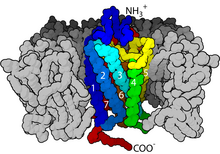細胞表面受體
(重定向自细胞表面受体)
細胞表面受體(cell surface receptor),是一類位於細胞表面的受體。細胞表面受體可以接收來自細胞外的信號,即與可以配對的配體結合,引發細胞內部的反應,最後產生特定的效應。這個效應可能僅在短時間內持續,比如細胞代謝或運動上的改變。也可能是長時間持續的,比如說使特定基因的表達上調[1][2]。總的來說,已發現的較經典細胞表面受體包括:G蛋白偶聯受體(G protein-coupled receptor)、受體酪氨酸激酶(Receptor tyrosine kinases)、鳥苷酸環化酶偶聯受體(Guanylate cyclase-coupled receptor)、離子通道(ion channel),以及黏附受體(adhesion receptor),其中以G蛋白偶連受體的數量最多[1][3]。

參見
编辑參考
编辑- ^ 1.0 1.1 Harvey Lodish; et al. Chapter 15. Molecular Cell Biology (7th edition). Macmillan Higher Education. 2013: 674–683. ISBN 978-1-4641-0981-2.
- ^ Functions of Cell Surface Receptors. The Cell: A Molecular Approach 2nd. NCBI. 2000 [2018-05-20]. (原始内容存档于2021-04-21).
- ^ David L. Nelson; Michael M. Cox; et al. Lehninger Priciples of Biochemistry 6th. New York: W. H. Freeman and Company. 2013: 436-484. ISBN 978-1-4292-3414-6.